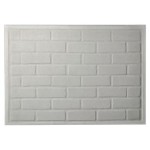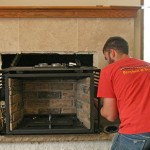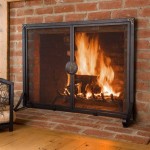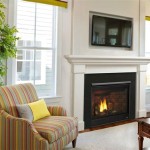Exploring the World of Ventless Indoor Fireplaces
Ventless indoor fireplaces, also known as vent-free fireplaces, have emerged as a popular alternative to traditional wood-burning or vented gas fireplaces. These appliances offer the allure of a cozy fire without the need for a chimney or venting system. This characteristic makes them attractive for homeowners who lack existing fireplace infrastructure or desire a fireplace in spaces where venting is impractical or cost-prohibitive. However, a thorough understanding of their operation, safety considerations, and potential drawbacks is crucial before considering the installation of a ventless indoor fireplace. This article aims to provide a detailed exposition on these aspects.
The primary appeal of ventless fireplaces lies in their ease of installation and versatility. Since they do not require a chimney, they can be placed in almost any room in the house, provided certain safety clearances and ventilation requirements are met. This flexibility makes them a viable option for apartments, condominiums, and homes where adding a traditional fireplace would be a major undertaking. They often come in various styles, from freestanding units to wall-mounted models and fireplace inserts, offering aesthetic adaptability to suit diverse interior design preferences.
Ventless fireplaces typically utilize propane or natural gas as fuel. They operate by burning the fuel very cleanly, aiming to produce minimal byproducts such as carbon monoxide. This process is facilitated by advanced burner technology and oxygen depletion sensors (ODS). The ODS is a critical safety feature that monitors the oxygen levels in the room. If the oxygen level drops below a pre-determined threshold, indicating a potential buildup of carbon monoxide, the ODS automatically shuts off the gas supply to the fireplace, preventing further combustion and mitigating the risk of carbon monoxide poisoning. This sensor is paramount for ensuring the safe operation of ventless fireplaces and distinguishes them from older, less safe models.
The efficiency of ventless fireplaces is another significant advantage. Because they don't vent heat out of the house, they are able to transfer a higher percentage of the heat generated into the room. This can translate into lower heating bills, especially when used as a supplemental heating source. The efficiency of a ventless fireplace is typically measured in British Thermal Units (BTUs), and it's important to select a unit with a BTU rating appropriate for the size of the room where it will be installed. An oversized unit can lead to overheating and discomfort, while an undersized unit may not provide sufficient warmth.
Understanding the Operational Principles and Safety Mechanisms
The operation of a ventless fireplace hinges on a precisely engineered combustion process designed to minimize the production of harmful emissions. Natural gas or propane is supplied to a specially designed burner, where it is mixed with air and ignited. The burner is designed to ensure complete combustion, breaking down the fuel into carbon dioxide (CO2) and water vapor (H2O). While CO2 is a byproduct of all combustion processes, the key is to minimize the production of carbon monoxide (CO), a colorless, odorless, and highly toxic gas. Proper burner design and maintenance are critical for achieving this goal.
The oxygen depletion sensor (ODS) is the cornerstone of ventless fireplace safety. This sensor continuously monitors the oxygen concentration in the room. As the fireplace burns, it consumes oxygen. If the room is not adequately ventilated, the oxygen level will gradually decrease. When the oxygen level drops below a critical threshold, typically around 18%, the ODS triggers a shut-off mechanism, cutting off the gas supply to the burner. This prevents further combustion and the potential buildup of carbon monoxide. Regular inspection and testing of the ODS are crucial to ensure its reliable operation.
In addition to the ODS, ventless fireplaces often incorporate other safety features, such as flame failure devices and overheat protection. A flame failure device automatically shuts off the gas supply if the flame is extinguished for any reason, preventing the release of unburned gas into the room. Overheat protection mechanisms, such as thermal cutoffs, prevent the fireplace from overheating, which could damage the unit or pose a fire hazard. These safety features work in tandem to minimize the risks associated with operating a ventless fireplace.
Ventilation Requirements and Air Quality Considerations
While ventless fireplaces do not require a chimney, they do necessitate adequate ventilation to ensure safe operation and maintain acceptable air quality. The combustion process consumes oxygen and produces carbon dioxide and water vapor. Inadequate ventilation can lead to a buildup of these byproducts, resulting in stale air, increased humidity, and potentially elevated levels of carbon dioxide. While the ODS is designed to prevent carbon monoxide poisoning, maintaining proper ventilation is crucial for avoiding other air quality issues.
Most manufacturers recommend a minimum room size and ventilation requirements for their ventless fireplaces. These recommendations are typically based on the BTU rating of the unit and the potential volume of combustion byproducts. It's essential to adhere to these recommendations to ensure adequate airflow and prevent the buildup of pollutants. Opening a window or door slightly can often provide sufficient ventilation, but the specific requirements will vary depending on the size of the room and the output of the fireplace.
In addition to natural ventilation, mechanical ventilation systems, such as exhaust fans or air exchangers, can be used to improve air quality in rooms with ventless fireplaces. These systems can help to remove stale air and humidity, while also introducing fresh air into the room. This is particularly important in tightly sealed homes where natural ventilation is limited. Regular maintenance of ventilation systems is crucial to ensure their effective operation and prevent the buildup of pollutants.
Potential Drawbacks and Regulatory Considerations
Despite their advantages, ventless fireplaces also have potential drawbacks that must be considered before installation. One concern is the potential for increased humidity levels in the room. The combustion process produces water vapor, which can contribute to increased humidity. While this may be beneficial in dry climates, it can be problematic in humid regions, potentially leading to mold growth and other moisture-related issues. Regular monitoring of humidity levels and the use of dehumidifiers can help to mitigate this problem.
Another concern is the potential for the buildup of pollutants, even with proper ventilation and the ODS in place. While ventless fireplaces are designed to burn cleanly, they are not entirely emission-free. Trace amounts of carbon monoxide, nitrogen dioxide, and other pollutants can still be produced. Individuals with respiratory sensitivities, such as asthma or allergies, may be more susceptible to the effects of these pollutants. Installing carbon monoxide detectors and maintaining good ventilation practices can help to minimize the risks.
Regulatory considerations also play a role in the decision to install a ventless fireplace. Building codes and regulations regarding ventless fireplaces vary depending on the jurisdiction. Some areas may prohibit the use of ventless fireplaces altogether, while others may have specific requirements regarding their installation and operation. It's essential to check with local building officials and fire departments to ensure compliance with all applicable regulations. Failure to comply with these regulations can result in fines, penalties, and the potential for safety hazards.
Furthermore, some individuals simply dislike the smell associated with the combustion of propane or natural gas, even when the fireplace is operating correctly. This smell can be more noticeable in smaller, less ventilated spaces. While the smell is generally not harmful, it can be unpleasant for some people.
Ultimately, the decision to install a ventless indoor fireplace should be made after careful consideration of all the factors discussed above. Weighing the advantages of convenience and ease of installation against the potential drawbacks of humidity, air quality concerns, and regulatory restrictions is crucial. Consulting with qualified professionals, such as HVAC technicians and building inspectors, can provide valuable insights and guidance in making an informed decision.

The Best Indoor Ventless Fireplaces For Your Home Or Apartment
:max_bytes(150000):strip_icc()/ventless-gas-fireplaces-4160746-hero-f9d4bdcd9bd446eb84406de306f790ba.jpg?strip=all)
How To Pick Out A Ventless Gas Fireplace

Ventless Gas Fireplace Vent Free Modern

What Is A Ventless Gas Fireplace Experts In Gaithersbutg Md

Ventless Gas Fireplace Propane

Superior 43 Inch Vent Free Linear Gas Fireplace

Vent Free Gas Fireplaces Inserts Stoves Napolis Godby Hearth And Home

Duluth Forge Dual Fuel Ventless Gas Fireplace 26 000 Btu T Stat Control Antique White Finish Com

Considering A Ventless Gas Fireplace Here S What You Need To Know Bob Vila

Vent Free Inserts White Mountain Hearth
Related Posts








